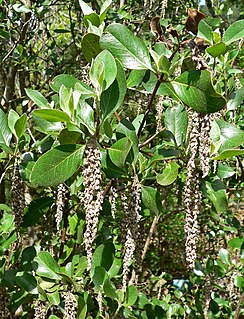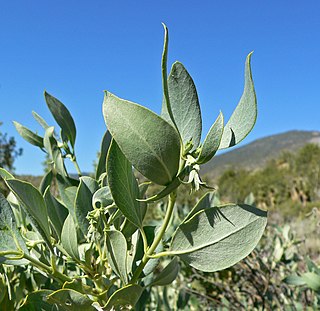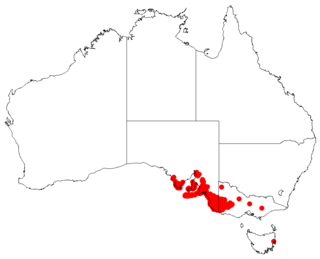
Garryaceae is a small family of plants known commonly as the silktassels. It contains two genera:

Garrya congdonii, the chaparral silktassel or Congdon silktassel, a fairly common evergreen shrub native to the northern California Coast Ranges, is one of a small biological family of approximately twenty known species in the family Garryaceae, most of which are Garrya. While the female and male sexual organs of Congdon silktassel are on separate plants, the pendant male catkins are much more showy. This plant is reasonably attractive and neat enough in its growing habit to be appealing as a landscape species. It is stocked commonly at commercial plant nurseries. All Garrya are associated with warm temperate regions of North America.

Garrya is a genus of flowering plants in the family Garryaceae native to Mexico, the western United States, Central America and the Greater Antilles. Common names include silk tassel and tassel bush.

Garrya elliptica, the coast silk-tassel, silk tassel bush or wavyleaf silktassel, is a species of flowering plant in the family Garryaceae, native to the coastal ranges of California and southern Oregon. It is an erect, bushy, evergreen shrub reaching a height of 2–5 m (7–16 ft).

Garrya buxifolia is a species of flowering shrub, known by the common names dwarf silktassel and boxleaf silktassel, in the genus Garrya.

Garrya flavescens is a species of flowering shrub, known by the common name ashy silktassel.

Garrya fremontii is a species of flowering shrub known by several common names, including California fever bush, bearbrush, and Frémont's silktassel. Both the latter name, and the plant's specific epithet are derived from John C. Frémont.

Arctostaphylos glauca is a species of manzanita known by the common name bigberry manzanita. It is native to California and Baja California, where it grows in the chaparral and woodland of coastal and inland hills.

Acmispon dendroideus, synonym Syrmatium veatchii, is a species of legume native to California. It is known by the common name island broom. It is endemic to the Channel Islands of California, where it grows on coastal bluffs and cliffs. It is a spreading perennial herb or erect shrub approaching 2 meters in height. It is hairless to hairy and gray-green in color. The branches lined with leaves each made up of a few oval leaflike leaflets up to 1.5 centimeters long each. The inflorescence bears up to 10 yellow pealike flowers, each roughly a centimeter long and fading red as they age.

Hakea rugosa, commonly known as wrinkled hakea or dwarf hakea, is a shrub of the family Proteaceae native to Australia. It has sharp needle-shaped leaves and white or cream fragrant flowers in profusion from August to October.
Garrya fadyenii is a species of flowering shrub known by the common name Fadyen's silktassel. It is native to the West Indies, specifically Jamaica, Hispaniola, and the former Cuban provinces of Oriente and Santa Clara. It grows in rocky areas of mountainous tropical rainforests.

Garrya wrightii is a species of flowering plant in the family Garryaceae known by the common names Wright's silktassel, quinine-bush, coffee berry, bearberry, feverbush, and grayleaf dogwood.

Xylomelum cunninghamianum is a species of flowering plant in the family Proteaceae and is endemic to eastern Australia. It is a shrub or small tree with narrow elliptic to lance-shaped leaves with toothed edges when young, groups of flowers covered with brownish hairs and oval fruit densely covered with velvety rust-coloured to grey hair.
Garrya ovata, with the common names eggleaf silktassel, Mexican silktassel, and eggleaf garrya, is a plant species native to New Mexico, Texas, and to central and northern Mexico.

Hakea candolleana is a shrub in the family Proteaceae native to areas along the west coast in the Wheatbelt and Mid West regions of Western Australia. A cream-white winter flowering species, useful as a garden ground cover.

Hakea kippistiana is a shrub in the family Proteacea and endemic to Western Australia. It is a dense prickly shrub with sharp needle-shaped leaves with fragrant white, cream or pink flowers from November to February.

Leucospermum praemorsum is an evergreen shrub or small tree of up to 5 m (16 ft) high. It has hairless oblong to inverted lance-shaped leaves of 7–8 cm long and 1½–2 cm wide, tapering at their base to a stalk of up to 2 cm long, and cut-off at the tip with three to five teeth, and pale carmine, inverted cone-shaped flower heads. From the center of the flowers emerge long initially orange, later deep crimson styles that jointly give the impression of a pincushion. It is called Nardouw fountain-pincushion or Nardouw pincushion in English and Nardouwluisiesbos in Afrikaans. Flower heads can be found off and on throughout the year, particularly in older plants, with a peak between July and December. It is an endemic species that can only be found in part of the Western Cape province of South Africa.

Leucospermum praecox is an evergreen, rounded, upright shrub of up to 3 m (9 ft) high, and 4 m (12 ft) in diameter that is assigned to the family Proteaceae. It has hairless, inverted egg-shaped to broadly wedge-shaped leaves of about 5 cm (2 in) long with six to eleven teeth near the tip, globe-shaped flower head with initially yellow flowers, later orange or scarlet, with styles sticking far out, giving the head the appearance of a pincushion. It is called Mossel Bay pincushion or large-tufted pincushion in English. It flowers between April and September. It is an endemic species that is restricted to the very south of the Western Cape province of South Africa.

Leucospermum wittebergense is an evergreen, upright to more or less spreading shrub of ½–1½ m (1⅔–5 ft) high and wide from the family Proteaceae. It has globe-shaped flower heads of about 2 cm (0.8 in) in diameter with initially whitish, later pinkish flowers. It has crowded, overlapping, inverted lance-shaped leaves, set at an upward angle and covered in short, dense grey-silvery shaggy hairs. From the center of the perianth emerge almost straight styles that jointly give the impression of a pincushion. It is called Swartberg pincushion in English. The species naturally occurs in the Western Cape province of South Africa. It can be found flowering between August and January.

Leucospermum spathulatum is an evergreen, spreading and mat-forming shrub, that has been assigned to the family Proteaceae. It has inverted egg-shaped to spade-shaped mostly greyish softly hairy leaves, mostly without teeth and flattened globe-shapec flower heads of 5–7 cm (2.0–2.8 in) across, consisting of deep orange to crimson flowers, the bud and the style curving toward the center. It can be found in the Western Cape province of South Africa. The common name in English is Cederberg pincushion. It flowers between September and January, with a peak at the end of October.

















